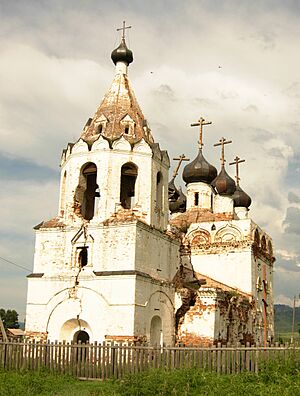Transbaikal facts for kids
Transbaikal, also known as Transbaikalia or Dauria, is a large, mountainous area in Russia. It is located to the east of Lake Baikal. The name "Transbaikal" means "beyond Baikal".
This region is famous for its wide-open steppes and wetlands. Many of these natural areas are protected. For example, the Daurian Nature Reserve is here. This reserve is part of a special World Heritage Site called "The Landscapes of Dauria."
Contents
What's in a Name?
The name Dauria comes from the Daur people. These people lived in the area a long time ago. Russian explorers first met the Daur people in 1640. That's how the region got its other name.
Where is Transbaikal?
Transbaikal stretches for about 1,000 kilometers (620 miles) from north to south. It goes from the Patom Plateau down to the borders with Mongolia and China. From west to east, it also covers more than 1,000 kilometers. This area goes from Lake Baikal to where the Shilka and Argun Rivers meet.
To the west and north of Transbaikal is the Irkutsk Oblast. To the north, you'll find the Republic of Sakha (Yakutia). The Amur Oblast is located to the east.
A Look at Transbaikal's History
Long ago, a group of people called the Slab Grave Culture lived near Lake Baikal. Their ancient settlements were found in the Transbaikal area.
Later, during the time of the Russian Empire, Dauria became an official region. It was called the Transbaikal Oblast. This was set up in 1851. The main city was first Nerchinsk, then later Chita. For a short time between 1920 and 1922, it was part of the Far Eastern Republic.
Today, the historic Transbaikal region includes Buryatia and the Zabaykalsky Krai. These two areas are important parts of Russia.
Amazing Animals and Plants
The Transbaikal region is home to many unique species. Some animals are even named after Dauria! These include the Daurian hedgehog.
Many birds also carry the name:
- The Asian brown flycatcher (Muscicapa daurica)
- The Daurian jackdaw
- The Daurian partridge
- The Daurian redstart
- The Daurian starling
- The Daurian shrike
- The red-rumped swallow (Hirundo daurica)
Sadly, the Mongolian wild ass (Equus hemionus hemionus) no longer lives in this region.
Plants also share the Daurian name. The famous Dahurian larch (Larix gmelinii) is one example. Another is the Dahurian buckthorn (Rhamnus davurica).
Protecting Nature: Dauria Nature Reserve
Part of the Transbaikal area is protected. This special place is called the Dauria Nature Reserve. It helps keep the unique animals and plants safe.
See also
 In Spanish: Transbaikalia para niños
In Spanish: Transbaikalia para niños




